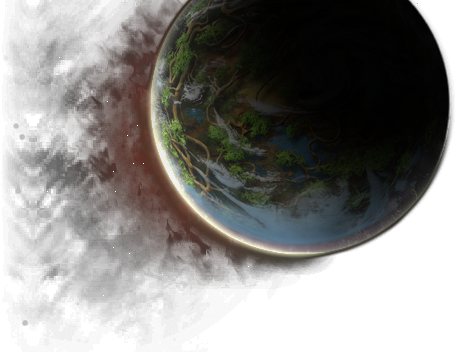Homin physiology
Q: What colour is the sap of homins?A: When a homin cuts himself, a red fluid flows out of him: blood. There is no other fluid of green colour or other. Sap is their blood, often named so because of this predominantly plant world.
However homins also designate by the word "sap" something which is tangible, though invisible, and which magic practitioners know well. Some claim that it is this same sap which determines the race of a homin.
Q: Do resurrections erase scars and amputations?
A: By nature, homins have considerable regenerative ability, simply by resting. The resurrection, just like the healing magic, erases any wound which immediately preceded it. However, if a homin being is recovering from a serious injury slowly, the after-effects will be "part of him", and will be retained in subsequent resurrections.
Q: Apart from the variations of natural resistances to magic, are there other differences between homin races?
A: The differences are mainly cultural. For example the Fyros were the only ones to cook their food and eat meat. The Trykers ate a lot of fish, while the Matis and Zoraï ate insects.
But during the time of the Exodus, after the first Great Swarming, when most of the surviving homins lived in a close confinement, differences between them lessened, out of necessity and also curiosity.
The Lore texts sometimes evoke physical differences or competences according to the race: the warrior Fyros, the magician Zoraï, etc. One can also find these traits in the way in which the four tutors of Silan are embodied. But the gameplay choices put everyone on a par.
Q: Does the death penalty make sense in roleplaying?
A: It is a particular trauma left by the process of resurrection. It does not affect the body physically (once treated homin beings finds themselves in possession of all their capacities) but it temporarily inhibits their ability to learn, as if they first have to "resynchronize" themselves with their bodies.
Q: Are the Zoraï masks fused to the skull or only hooked to the muscles and skin and of what material are they made?
A: The Zoraï mask is inseparable from the skull at the forehead, but covers the face below like the nail covers the tip of the finger.
The mask is made of organic tissue, bone and cartilage.
Q: In what situation is a Goo infection definitely fatal?
A: Dying from Goo contamination implies a definitive alteration to the Seed of Life and therefore the impossibility of resurrection. Absolutely lethal (without the possibility of resurrection) are the ingestion and injection of Goo. On the other hand, as long as one has not reached the final stage of the disease, an infected homin being can have access to resurrection if, for example, he is killed by a predator or an enemy. However, do not trust in the longevity of Supplice or Lenja (characters of the Zoraï rite) or even Pei-Ruz, to deduce that one can live long while being contaminated. This is not the case! Supplice is a totally unique case that we absolutely can not use to generalize. Normally, contamination causes death much more quickly. That said, we will not risk to specify a time limit that would certainly be too restrictive for you. Just keep in mind that you will not survive such an infection for very long.


